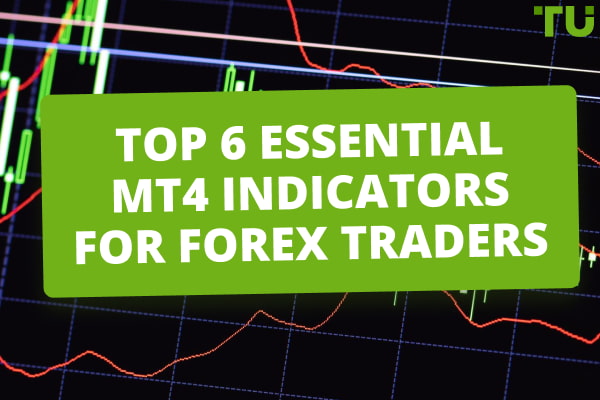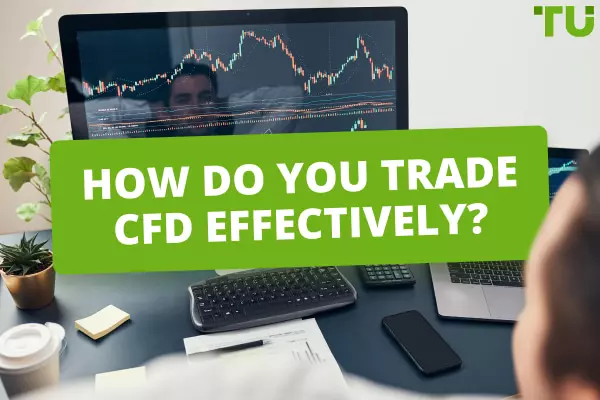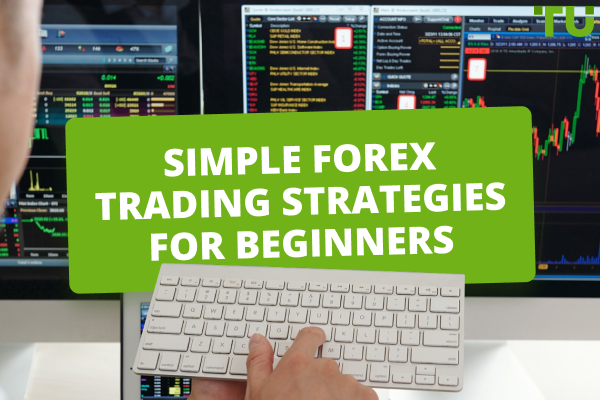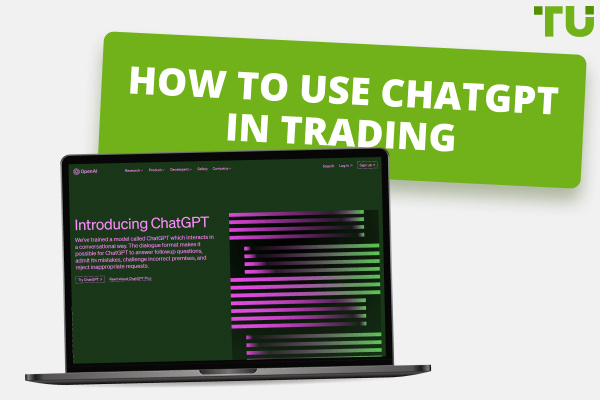Best Moving Average Strategies To Know - Traders Union
The use of moving averages is popular for traders and investors alike. By smoothing out price data over a specified period, moving averages can help traders identify trends, spot potential entry and exit points, and gauge the overall direction of the market. Moving average crossover strategies, in particular, have gained significant popularity among traders, as they provide a clear signal for when to enter or exit a trade. So, in this article, the experts at TU explore some of the best moving average crossover strategies and how they can be applied to various trading scenarios.
According to Traders Union’s experts, the best moving average crossover strategies are:
The Moving Average Ribbon Entry Strategy.
The Golden Cross Strategy.
The 13-EMA and 26-EMA Strategy.
The Death Cross Strategy.
What is a moving average?
Moving averages are commonly used in technical analysis to help traders identify trends and potential entry and exit points in the markets. They are calculated by taking the average of a set of numeric values over a predefined length or subset size. As new data is added, the set of values moves forward, with the first element of the moving average series obtained by averaging the initial subset of the numeric values.
Moving averages can be calculated using different durations or lookback periods, ranging from minutes to hours, depending on the trader's preference. However, it's important to note that moving averages are lagging indicators, as they use historical data to compute the average.
Faster moving averages with shorter lookback periods generally respond faster to changes in the market compared to slower moving averages with longer lookback periods. Moreover, fast moving averages are less reactive to daily price changes and are useful for short-term trading.
According to analysts, moving averages are commonly applied to stock and derivative prices, percentage returns, yields, and trading volumes in financial markets. Understanding them is crucial for traders who want to improve their trading performance. By using moving averages, traders can identify trends and potential entry and exit points, make informed decisions, and improve their chances of success in the markets.
Types of moving averages
Types of moving averages
Moving averages can be calculated using different methods, and traders can choose the type of moving average that best suits their trading strategy. Here are some of the most common types of moving averages as identified by our experts:
Simple Moving Average (SMA): The simple moving average is calculated by taking the sum of the numeric values over a defined period and dividing it by the number of values in the subset. It is a basic method of calculating moving averages and is commonly used by traders.
Weighted Moving Average (WMA): The weighted moving average gives more weight to recent data points in the subset, making it more responsive to changes in the market. Traders who want to place more emphasis on recent price data may prefer the WMA over the SMA.
Exponential Moving Average (EMA): The exponential moving average is similar to the WMA but places even more weight on the most recent data points. This makes it the most responsive of the three methods to changes in the market. Traders who want to be more responsive to market changes may prefer the EMA over the SMA and WMA.
Smoothed Moving Average (SMMA): The smoothed moving average is calculated by averaging the sum of the previous moving average with the current numeric value. This results in a smoother curve compared to the SMA, making it useful for identifying longer-term trends.
Adaptive Moving Average (AMA): The adaptive moving average adjusts its sensitivity to changes in the market based on the volatility of the security being traded. It is designed to be more responsive during volatile market conditions and less responsive during stable market conditions.
Top 4 moving average strategies
Experts have identified the following to be the top 4 moving average strategies:
Moving Average Ribbon Entry Strategy
This strategy generally uses a combination of 5-8-13 simple moving averages (SMAs) on a two-minute chart to find strong trends for buying or selling short on counter swings. Traders can enter a buy or sell position depending on the trend's direction when the ribbons align and indicate an upward or downward trend. If the ribbons level out and the price frequently crosses the ribbon in a ranging market, traders should wait for the ribbons to realign with them either rising or falling, indicating more room between each line.
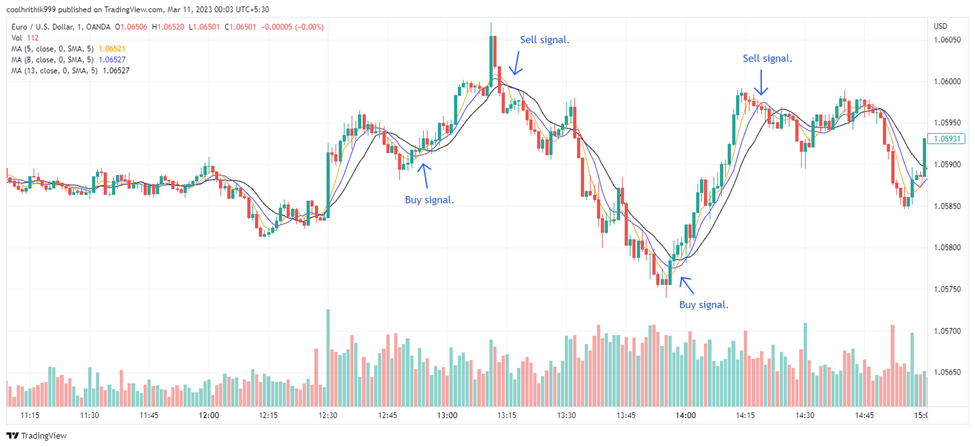
Moving Average Ribbon Entry Strategy
Golden Cross Strategy
In this strategy, traders look for the 50-day simple moving average to cross over the 200-day simple moving average and stay above it until the end of the day. If this phenomenon prevails, a bullish movement is expected. Simply put, traders can enter a long position when the 50-day simple moving average closes above the 200-day simple moving average. To exit the position, traders should wait for the 50-day SMA to close below the 200-day SMA, which is a bearish signal.
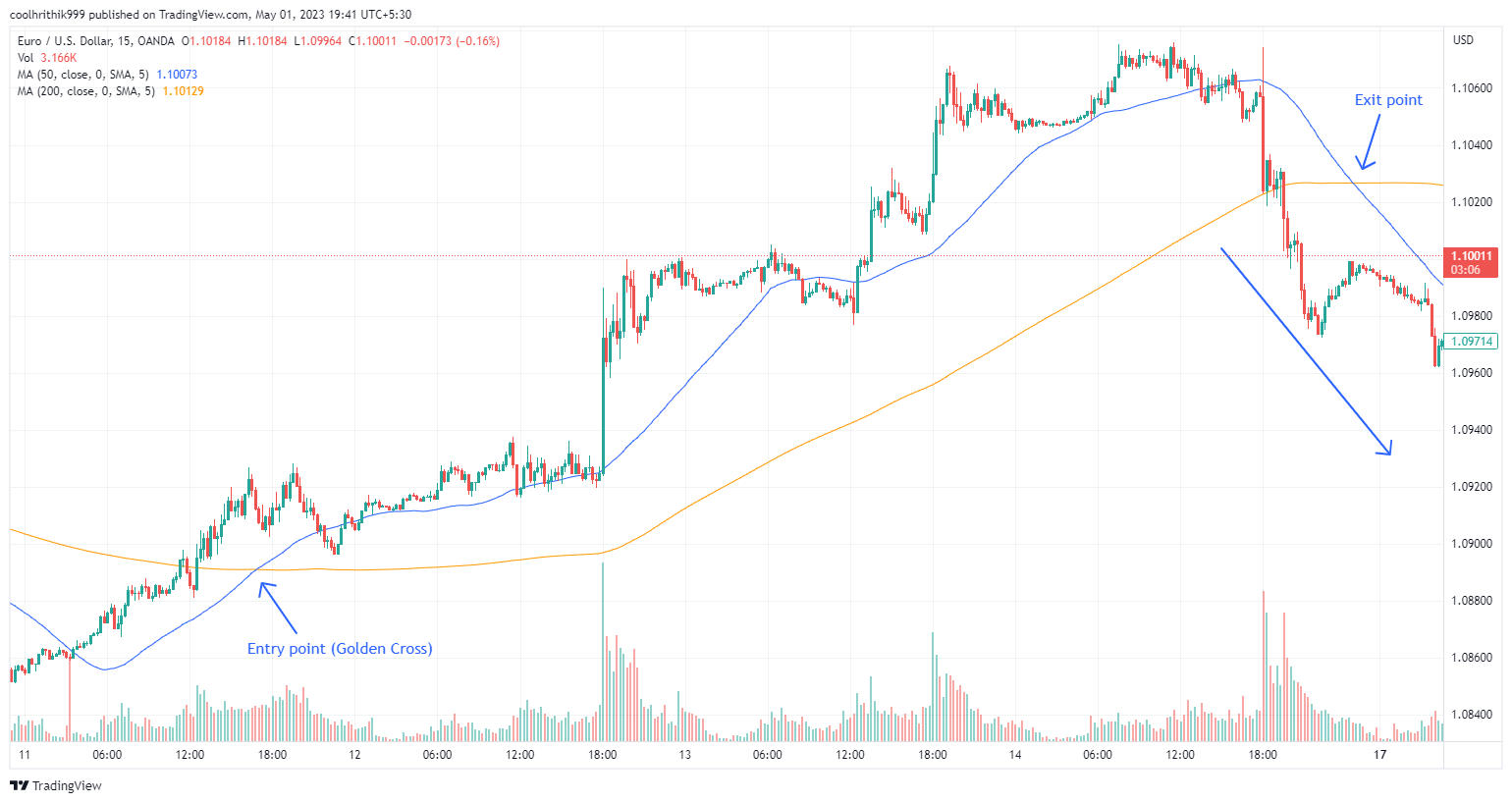
Golden Cross Strategy
13-EMA and 26-EMA Strategy
This strategy involves plotting the 13-EMA and 26-EMA on a chart to identify potential trend reversals. When the 13-EMA crosses above the 26-EMA, it indicates a bullish trend, and traders can enter a long position. When the 13-EMA crosses below the 26-EMA, it indicates a bearish trend, and traders should exit their long positions.
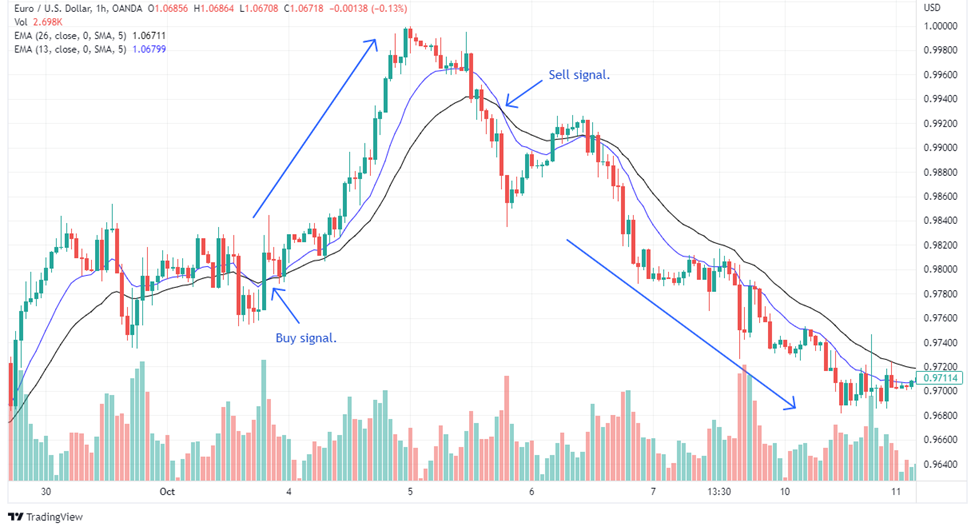
13-EMA and 26-EMA Strategy
Death Cross Strategy
This strategy involves observing when the short-term moving average (e.g., 50-day) of a security crosses below a long-term moving average (e.g., 200-day), indicating the transition from a bull market to a bear market. When traders observe this signal, they should consider closing their long positions or even consider taking a short selling position to make a profit.
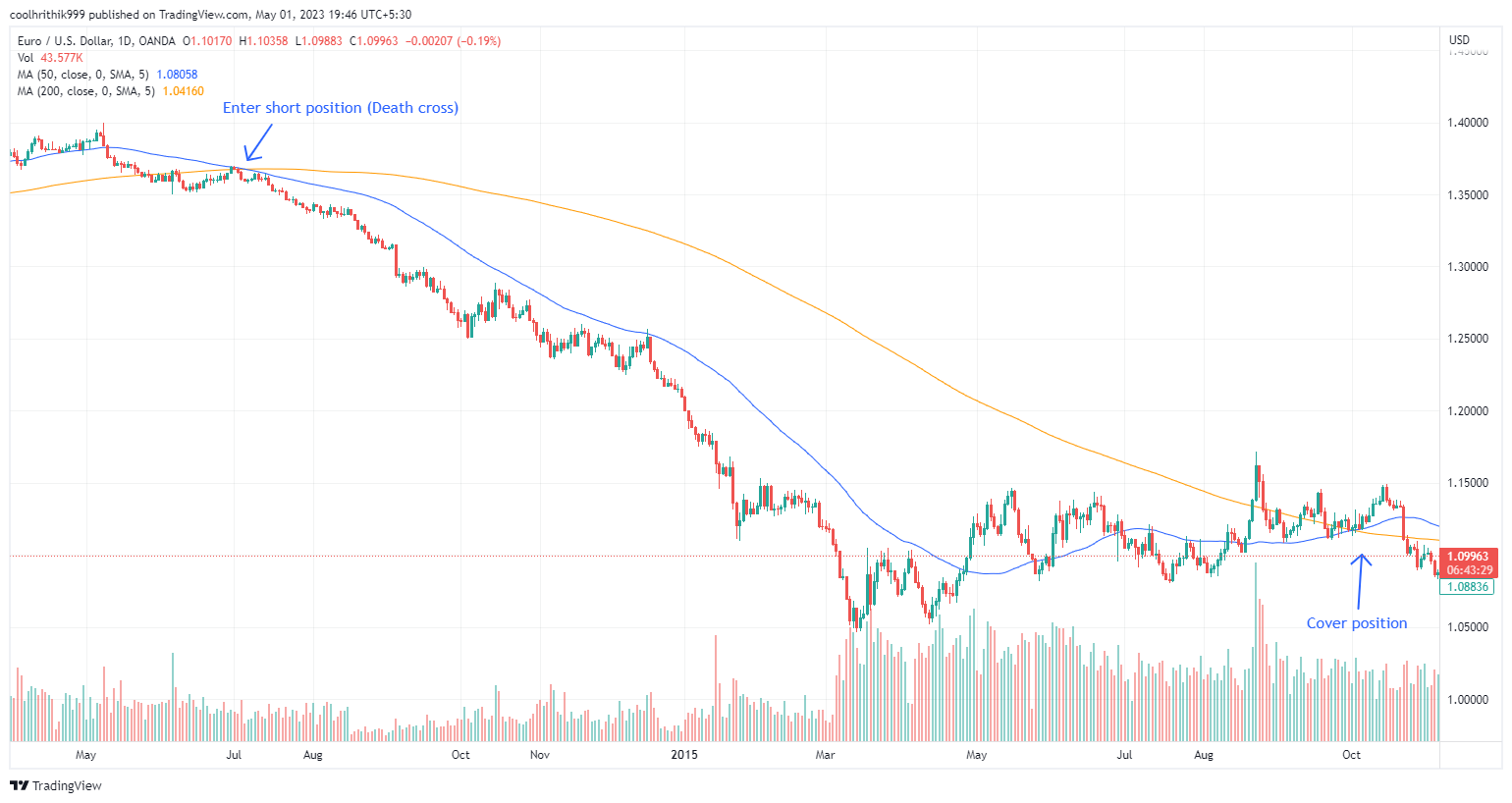
Death Cross Strategy
Best Forex brokers 2024


How to use moving averages correctly?
Moving averages can be powerful tools for traders to identify trends and potential entry and exit points in the markets. However, it's important to use them correctly in order to make informed decisions and potentially improve your trading performance. Here are some tips for using moving averages effectively:
Choose the right type of moving average: As discussed earlier, there are different types of moving averages, such as SMA, WMA, EMA, SMMA, and AMA. Choose the type that best suits your trading strategy and helps you achieve your objectives.
Choose the right lookback period: The lookback period is the duration over which the moving average is calculated. Choosing the right lookback period depends on the trader's preference and the intended use of the moving average. A longer lookback period may result in a smoother curve and help identify longer-term trends, while a shorter lookback period may be more responsive to short-term market changes.
Use multiple moving averages: Using multiple moving averages of different durations can help identify different trends and potential entry and exit points. For example, a trader may use a shorter-term moving average to identify short-term trends and a longer-term moving average to identify longer-term trends.
Use moving averages in combination with other technical tools: Moving averages can be used in combination with other technical tools, such as Bollinger Bands and Relative Strength Index (RSI), to provide a more complete picture of the market.
Pay attention to support and resistance levels: Moving averages can be used to determine levels of support and resistance, which can help traders identify potential entry and exit points.
Regularly monitor and adjust your moving averages: Market conditions can change rapidly, and it's important to regularly monitor and adjust your moving averages to reflect these changes.
Are moving averages efficient?
The effectiveness of moving averages can vary depending on the type and duration of the moving average used. Here's what recent research has revealed about the efficiency of moving averages in trading:
Exponential moving averages (EMAs) perform better overall than simple moving averages (SMAs): EMAs weigh recent prices more heavily than earlier prices, making them more responsive to changes in the market. This makes them a better choice overall for traders.
Short- and long-term EMAs generate the highest crossover trading returns: ETF HQ tested a massive number of combinations of moving averages using 300 years of daily and weekly data from 16 global indices. They found that trading the crossovers of the 13-day and 48.5-day EMAs generated the largest returns for traders.
The conventional 50-day and 200-day SMAs may not be the best averages to trade: While the 50-day and 200-day SMAs are commonly used in determining crossovers, recent research suggests that traders may benefit from using shorter-term EMAs instead.
In summary, moving averages can be effective tools for traders when used correctly. Experts suggest that EMAs are generally more effective than SMAs, and traders may benefit from using short- and long-term EMAs to generate the highest crossover trading returns. It's important for traders to regularly monitor and adjust their moving averages to reflect changes in the market and improve their chances of success.
Now, let’s look at how experts have bifurcated this technical analysis tool into pros and cons.
👍 Pros
•Identifying trends in the market: Moving averages can help traders identify whether the market is in an uptrend or downtrend based on the position of the price relative to the moving average.
•Identifying entry and exit points: Traders can use moving averages to identify potential entry and exit points based on trends in the market.
•Acting as support and resistance points: Moving averages can also act as support or resistance levels in the market.
•Smoothing out price data: Moving averages help to level the price data over a specified period, making the indicator more responsive to new and updated information, and potentially improving predictions.
👎 Cons
•Generating false signals in volatile or sideways markets: When the price action becomes fluctuating or trades within a stable range, moving averages may generate false signals, leading to potential losses.
•Poor performance in fluctuating or ranging markets: Moving averages tend to work best in strong trending conditions but may perform poorly in fluctuating or ranging markets, requiring traders to adjust the time frame or utilize additional indicators to confirm trends.
•Not suitable for all trading styles: Moving averages may not be the best indicator for all trading styles, and traders may need to experiment with different indicators and strategies to find what works best for them.
Expert Opinion
I believe moving average crossover strategies can be effective tools when applied properly.
In my experience, combining multiple time frames and asset classes is a good way to improve this approach. For example, looking at crossovers on both daily and 4-hour charts, or across related currency pairs, can help confirm signals. This multi-timeframe and multi-asset analysis gives a more holistic picture of the overall market trend.
Second, moving averages need sufficient market volatility and volume to provide reliable signals. In ranging or low volatility markets, they may generate a lot of unwanted noise. It's best to wait for clearer trends to develop before taking trades. Impatience can result in whipsaw trades.
Third, combining moving averages with other indicators can help confirm signals and filter out false positives. I like to see volume spikes and candlestick patterns supporting crossover signals. Oscillator indicators (MACD, RSI, stochastic) also help gauge momentum shifting and the strength of trends.
FAQ
Which moving average crossover is the best?
The best moving average crossover depends on the individual trader's goals, preferences, and trading style. However, recent research suggests that using a combination of short- and long-term exponential moving averages (EMAs) can generate the highest crossover trading returns.
Is moving average crossover a good strategy?
Moving average crossover can be a good strategy for traders looking to identify trends and potential entry and exit points in the markets. However, like any trading strategy, it has its advantages and disadvantages, and traders should carefully evaluate their goals and risk tolerance before implementing the strategy.
What is the most successful moving average strategy?
The most successful moving average strategy depends on the individual trader's goals, preferences, and trading style. However, recent research suggests that using a combination of short- and long-term exponential moving averages (EMAs) can generate the highest crossover trading returns.
What is a fast moving average crossover strategy?
A fast moving average crossover strategy involves using short-term moving averages to identify potential entry and exit points in the markets. This strategy is designed to be more responsive to changes in the market and can generate quick profits on counter swings. However, it can also be more risky due to the short-term nature of the moving averages used.
Glossary for novice traders
-
1
Broker
A broker is a legal entity or individual that performs as an intermediary when making trades in the financial markets. Private investors cannot trade without a broker, since only brokers can execute trades on the exchanges.
-
2
Trading
Trading involves the act of buying and selling financial assets like stocks, currencies, or commodities with the intention of profiting from market price fluctuations. Traders employ various strategies, analysis techniques, and risk management practices to make informed decisions and optimize their chances of success in the financial markets.
-
3
Long position
A long position in Forex, represents a positive outlook on the future value of a currency pair. When a trader assumes a long position, they are essentially placing a bet that the base currency in the pair will appreciate in value compared to the quote currency.
-
4
Volatility
Volatility refers to the degree of variation or fluctuation in the price or value of a financial asset, such as stocks, bonds, or cryptocurrencies, over a period of time. Higher volatility indicates that an asset's price is experiencing more significant and rapid price swings, while lower volatility suggests relatively stable and gradual price movements.
-
5
Investor
An investor is an individual, who invests money in an asset with the expectation that its value would appreciate in the future. The asset can be anything, including a bond, debenture, mutual fund, equity, gold, silver, exchange-traded funds (ETFs), and real-estate property.
Team that worked on the article
Chinmay Soni is a financial analyst with more than 5 years of experience in working with stocks, Forex, derivatives, and other assets. As a founder of a boutique research firm and an active researcher, he covers various industries and fields, providing insights backed by statistical data. He is also an educator in the field of finance and technology.
As an author for Traders Union, he contributes his deep analytical insights on various topics, taking into account various aspects.
Dr. BJ Johnson is a PhD in English Language and an editor with over 15 years of experience. He earned his degree in English Language in the U.S and the UK. In 2020, Dr. Johnson joined the Traders Union team. Since then, he has created over 100 exclusive articles and edited over 300 articles of other authors.
Mirjan Hipolito is a journalist and news editor at Traders Union. She is an expert crypto writer with five years of experience in the financial markets. Her specialties are daily market news, price predictions, and Initial Coin Offerings (ICO).


